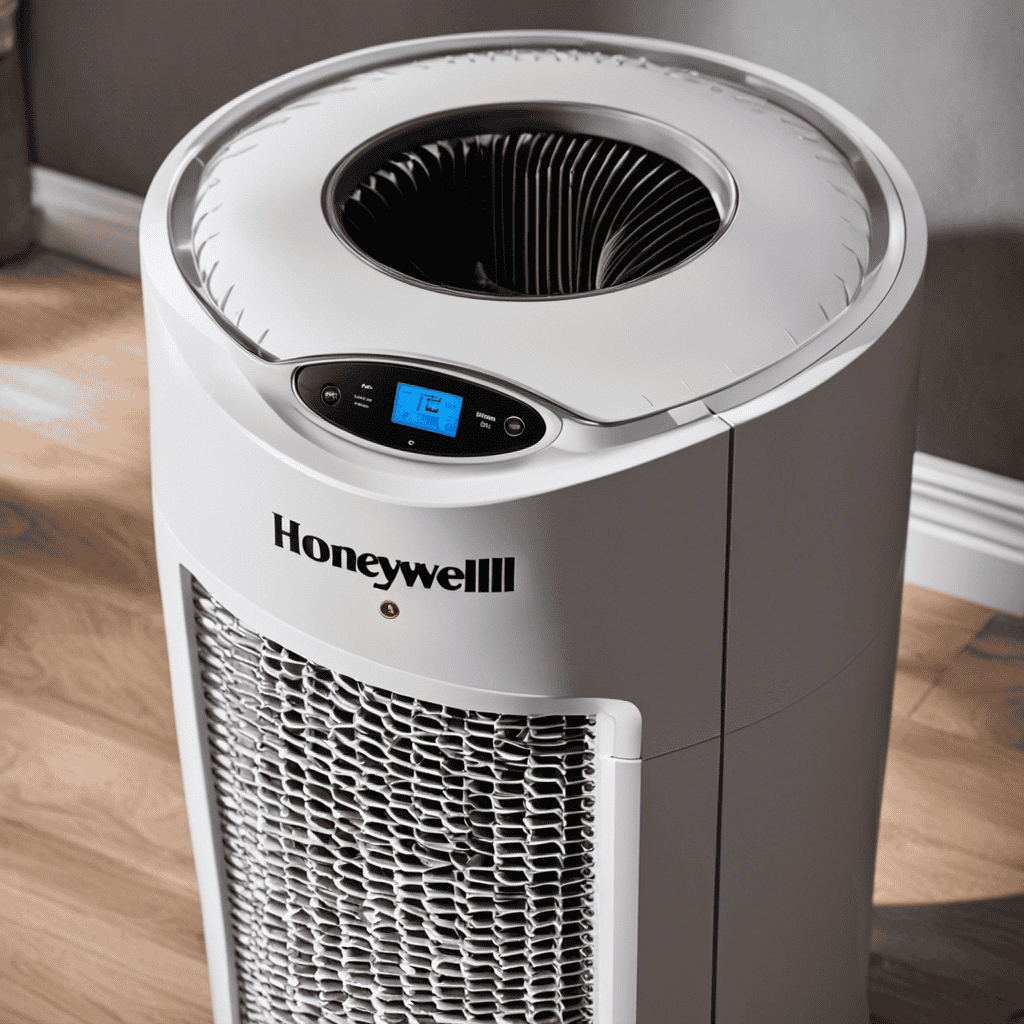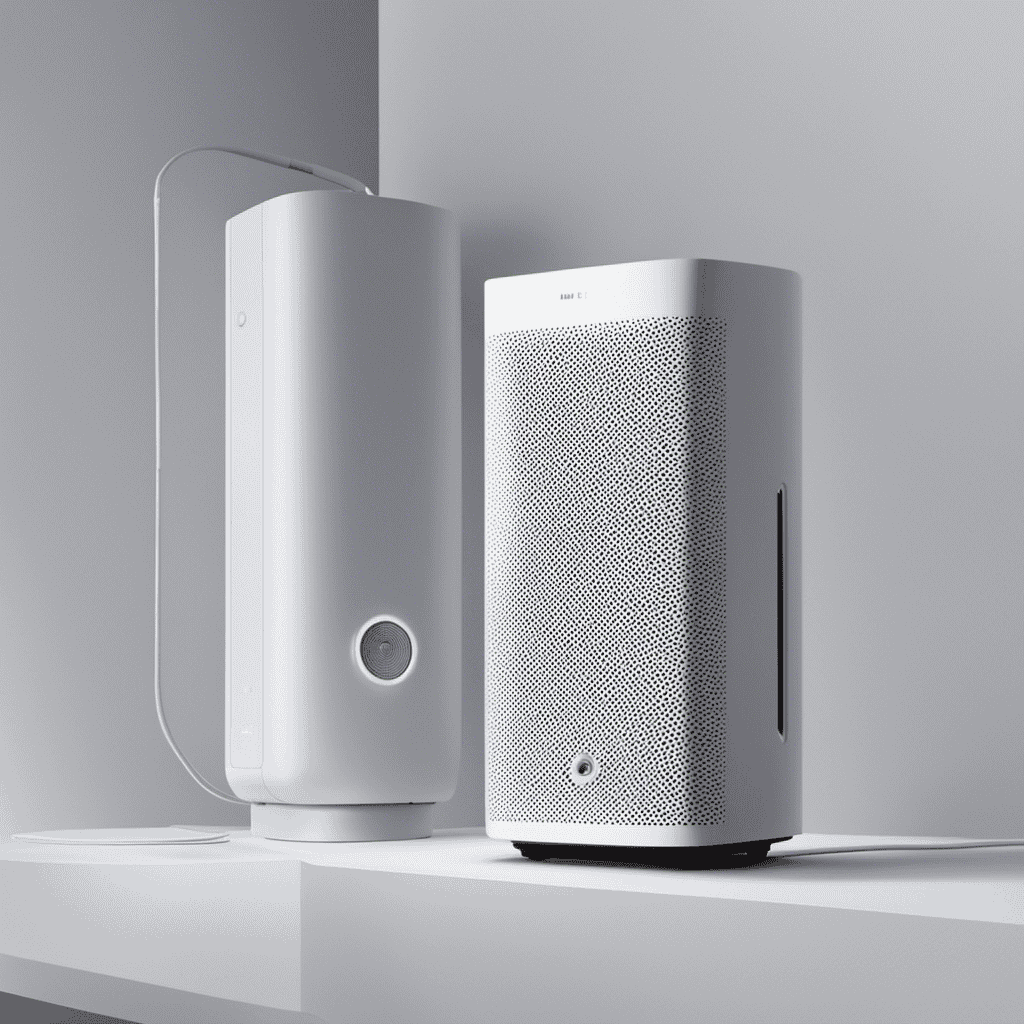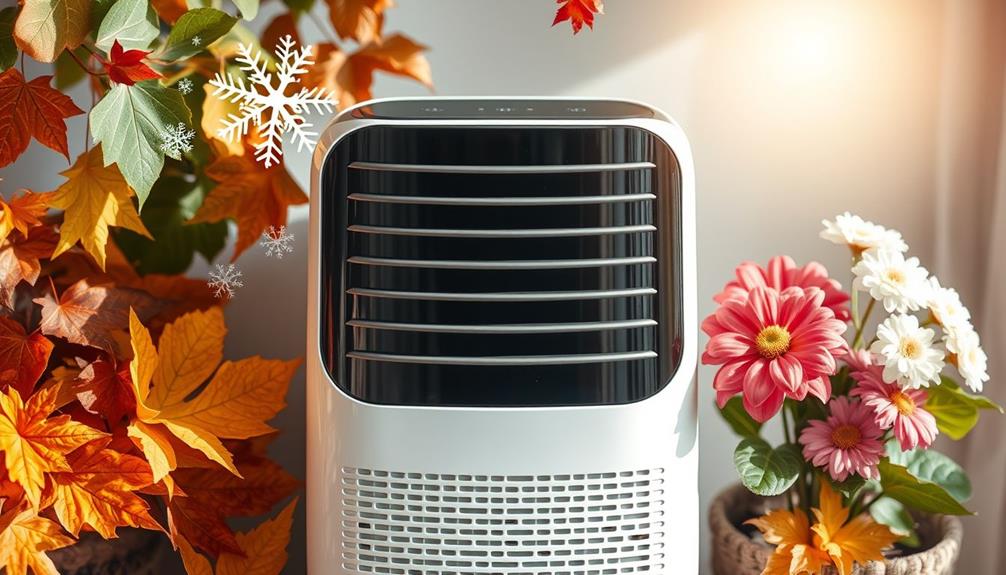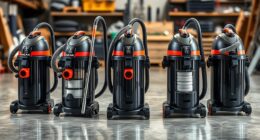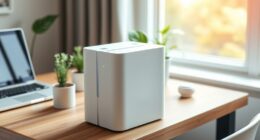As I relax in my home, enjoying the fresh, purified air, it makes me ponder: when should I switch off my air purifier? Comprehending the best way to utilize this vital tool is key to preserving a wholesome atmosphere indoors.
In this article, I will delve into the factors affecting air quality, the ideal time to switch off the air purifier, and the health benefits and performance maintenance that come with it.
So, let’s dive in and unravel the mysteries of when to turn off the air purifier.
Key Takeaways
- Monitoring air pollution is crucial for determining when to turn off the air purifier
- An AQI below 50 generally indicates it is safe to turn off the purifier
- An AQI above 50 suggests keeping the purifier running for clean indoor air
- Regular monitoring and understanding air quality levels are essential for maintaining a pollutant-free environment
Understanding Air Quality Levels
To understand when to turn off your air purifier, you need to be aware of the current air quality levels. Monitoring air pollution is crucial in determining the effectiveness of your air purifier usage. By keeping track of the air quality index (AQI) in your area, you can make informed decisions about when to turn off your purifier.
When the air quality is good, with an AQI below 50, it is generally safe to turn off the purifier and let the natural ventilation do its job. However, if the AQI rises above 50, it is recommended to keep the purifier running to ensure clean and healthy air indoors.
Understanding the air quality levels is the first step in effective air purifier usage and maintaining a pollutant-free environment.
Transitioning into the next section, let’s now discuss the importance of monitoring indoor pollutants.
Monitoring Indoor Pollutants
Make sure you’re keeping an eye on the levels of indoor pollutants in your home. Indoor air pollution monitoring is crucial to ensure the air you breathe is clean and healthy.
By using effective air purifier usage, you can significantly reduce the presence of harmful pollutants. It’s important to understand that air purifiers work by filtering out pollutants from the air, but they do not eliminate them completely. Regular monitoring is necessary to determine when to turn off the air purifier.
One way to monitor indoor pollutants is by using air quality monitors. These devices measure and display the levels of pollutants in real-time, allowing you to take necessary actions to improve the air quality.
Monitoring indoor pollutants and using air purifiers effectively go hand in hand to create a healthier indoor environment for you and your family.
Ideal Time to Turn off the Air Purifier
When it’s time to give your air purifier a break, you should consider the ideal moment to stop using it. While air purifiers are incredibly useful in improving indoor air quality, they also have a lifespan that needs to be taken into account.
Here are a few things to keep in mind when deciding when to turn off your air purifier:
-
Nighttime use: If you use your air purifier primarily during the day, turning it off at night can help conserve its lifespan and reduce energy consumption.
-
Air quality: If the air in your home is consistently clean and free of pollutants, you may not need to run your air purifier continuously. Turning it off when the air is already clean can help extend its lifespan.
-
Maintenance: Regularly cleaning and replacing filters is essential for the proper functioning of your air purifier. Turning it off during maintenance can help ensure you perform these tasks correctly.
-
Noise and sleep: Some air purifiers can be noisy, which can disrupt your sleep. Turning it off at night can create a quieter sleeping environment.
Factors Affecting Air Quality
The factors that affect air quality can have a significant impact on the effectiveness of an air purifier. Understanding outdoor pollutants and the impact of air pollution on health is crucial in determining the effectiveness of an air purifier.
Outdoor pollutants such as particulate matter, volatile organic compounds (VOCs), and nitrogen dioxide can enter indoor spaces, compromising air quality. These pollutants can come from various sources like vehicle emissions, industrial activities, and burning of fossil fuels. Exposure to these pollutants has been linked to respiratory problems, cardiovascular diseases, and even cancer.
An air purifier with advanced filtration technologies can help remove these pollutants, improving indoor air quality and reducing the risk of health issues. However, it is important to note that air purifiers are more effective in smaller spaces, and factors like room size, pollution levels, and maintenance should be considered for optimal performance.
Determining Optimal Air Purifier Usage
To get the most out of your air purifier, you should consider factors such as room size, pollution levels, and maintenance. These factors play a crucial role in determining the optimal usage of your air purifier. Here are some key points to keep in mind:
-
Room size: Ensure that your air purifier is suitable for the size of the room you want to purify. Using an undersized purifier may not effectively clean the air, while an oversized one may consume excessive energy.
-
Pollution levels: If you live in an area with high pollution levels, you may need to run your air purifier for longer periods to maintain clean indoor air.
-
Maintenance: Regularly cleaning and replacing filters is essential for optimal performance and prolonging the lifespan of your air purifier.
-
Air purifier lifespan: While maintenance can extend the lifespan of your purifier, it is important to note that air purifiers have a finite lifespan, typically ranging from 5 to 10 years.
Considering these factors and performing regular maintenance will ensure that your air purifier functions optimally and lasts for years to come.
Now, let’s delve into nighttime air purifier considerations.
Nighttime Air Purifier Considerations
At night, it’s important to keep your air purifier running to maintain clean indoor air quality while you sleep. However, it’s crucial to consider the impact of nighttime noise levels on your sleep quality as well.
While air purifiers are designed to operate quietly, some models can still produce a low hum or white noise that may disturb light sleepers. If you are sensitive to noise, it may be best to choose a model specifically designed to operate silently or to use a noise machine to help mask any sounds.
Additionally, placing the air purifier away from your bed or using a timer to turn it off after a few hours can minimize any potential disruptions to your sleep. By finding the right balance between clean air and a peaceful sleep environment, you can enjoy the benefits of your air purifier without compromising your rest.
Seasonal Variations in Air Purifier Use
When it comes to seasonal variations in air purifier use, there are a few key points to consider.
Firstly, allergies and pollen can be a major concern during certain times of the year, and having an air purifier can help reduce the allergens in your home.
Secondly, humidity and mold can also become an issue, especially in humid climates or during the rainy season. An air purifier with a dehumidification feature can help maintain optimal indoor humidity levels and prevent the growth of mold.
Lastly, indoor air quality is important year-round, and using an air purifier can help remove pollutants and improve the overall air quality in your home.
Allergies and Pollen
If you’re suffering from allergies and pollen, keeping your air purifier on can help alleviate your symptoms. Pollen allergies can be particularly troublesome during certain seasons, such as spring and fall, when pollen levels are high.
Here are four reasons why having an air purifier can make a difference in managing seasonal allergies:
- Removes pollen particles from the air, reducing exposure and minimizing symptoms.
- Filters out other allergens like dust mites and pet dander, improving overall air quality.
- Helps relieve congestion and sneezing by reducing airborne irritants.
- Creates a clean and comfortable environment, allowing for better sleep and productivity.
Humidity and Mold
To prevent mold growth in your home, it’s important to keep the humidity levels in check. Mold thrives in damp environments, so controlling the moisture in your house is key to mold prevention.
High humidity levels provide the perfect conditions for mold spores to multiply and spread. To control humidity, make sure to use dehumidifiers in areas prone to excess moisture, such as your basement or bathroom.
Additionally, ensure proper ventilation by using exhaust fans in kitchens and bathrooms to remove steam and moisture from the air. Keep an eye out for signs of excessive moisture, such as condensation on windows or musty odors.
Indoor Air Quality
You can improve the indoor air quality in your home by regularly cleaning and dusting surfaces, as well as opening windows to allow fresh air to circulate. Understanding pollutants and taking steps to improve air quality is crucial for our overall well-being. Here are some key points to consider:
-
Reduce allergens: Dust mites, pet dander, and pollen can trigger allergies and asthma. Vacuum regularly and wash bedding in hot water to minimize these irritants.
-
Control humidity: High humidity levels can promote the growth of mold and mildew. Use a dehumidifier to maintain optimal humidity levels, between 30-50%.
-
Avoid toxic chemicals: Household products like cleaning sprays and air fresheners can release harmful chemicals into the air. Opt for natural alternatives or make your own cleaners using vinegar and baking soda.
-
Increase ventilation: Proper ventilation is essential to remove indoor air pollutants. Open windows when weather permits or use exhaust fans in kitchens and bathrooms.
Balancing Energy Consumption and Air Purification
When it comes to balancing energy consumption and air purification, there are several strategies that can help optimize efficiency.
One key strategy is to use the air purifier during specific times of the day when air pollution is at its peak, such as during rush hour or when outdoor activities are at their highest.
Energy-Saving Strategies
Using energy-saving strategies can help reduce the amount of electricity consumed by your air purifier. Here are some tips to help you save energy and reduce your environmental impact:
-
Use the air purifier only when needed: Turning it off when you’re not at home or when the air quality is already good can save energy.
-
Opt for energy-efficient models: Look for air purifiers with the ENERGY STAR label, as they are designed to consume less electricity.
-
Clean or replace filters regularly: Clogged filters make the air purifier work harder, leading to increased energy consumption.
-
Consider alternative purification methods: Some air purifiers use technologies like UV light or electrostatic precipitation, which can be more energy efficient than traditional filters.
Optimal Air Purification Time
When it comes to optimizing air purification, it’s important to consider the time of day. During the nighttime, the air quality tends to be better as there is less pollution and fewer allergens in the air. This makes it an ideal time to turn off your air purifier, especially if you want to save energy and reduce noise levels while you sleep.
However, even during the nighttime, it’s crucial to maintain your air purifier properly. Regular maintenance ensures that it operates efficiently and effectively. This includes cleaning or replacing the filters, removing any accumulated dust or debris, and checking for any signs of wear and tear.
Health Benefits of Turning off the Air Purifier
To maximize your health benefits, it’s important to turn off the air purifier when you don’t need it. While air purifiers are great for improving indoor air quality, keeping them on all the time may not be necessary and can have some drawbacks. Here are some reasons why turning off your air purifier can be beneficial:
-
Reduction in health risks: Continuous exposure to purified air can weaken our immune system, making us more susceptible to infections and allergies.
-
Cost analysis: Running an air purifier 24/7 can significantly increase electricity bills, especially if you have multiple units in your home.
-
Environmental impact: By turning off the air purifier when it’s not needed, you can save energy and reduce your carbon footprint.
-
Noise reduction: Some air purifiers can be noisy, especially at higher fan speeds. Turning them off when you don’t need them can create a more peaceful environment.
Maintaining Air Purifier Performance
If you neglect regular maintenance, your air purifier may not perform effectively.
One crucial aspect of maintaining air purifier performance is managing dust accumulation. Over time, dust particles can build up on the surface and inside the device, reducing its efficiency.
To prevent this, it is essential to clean the air purifier regularly. Wiping down the exterior with a damp cloth and using a soft brush to remove dust from the vents and grilles can help maintain optimal performance.
Another crucial maintenance task is filter replacement. Air purifiers have filters that trap pollutants and allergens, but these filters can become clogged over time. It is recommended to check the manufacturer’s instructions for the recommended filter replacement schedule and follow it diligently.
Signs That Indicate the Need to Turn off the Air Purifier
Excessively clean indoor air and unnecessary energy consumption are two issues that often go hand in hand.
When we strive for air that is too clean, we may end up using energy-intensive purification systems that constantly run, even when the air quality is already good. This not only wastes energy but also increases our carbon footprint, contributing to environmental degradation.
Excessively Clean Indoor Air
You should consider turning off your air purifier if the indoor air is excessively clean. While it may seem counterintuitive, there are certain situations where having pristine air can actually be detrimental to your health.
Here are a few reasons why excessively clean indoor air may pose health risks:
- Reduced exposure to natural bacteria and allergens can weaken the immune system.
- Lack of microbial diversity can lead to an increased risk of allergies and asthma.
- Overly sterile environments can hinder the development of a healthy microbiome.
- Excessive cleaning precautions may result in the use of harsh chemicals that can be harmful when inhaled.
Unnecessary Energy Consumption
To avoid unnecessary energy consumption, it’s important to consider the amount of power your air purifier uses when it’s running constantly. By reducing electricity usage, we can minimize our carbon footprint and contribute to a greener environment.
When choosing an air purifier, look for models with energy-saving features such as low power consumption and automatic shut-off timers. These features can help you save energy and reduce your electricity bills.
Additionally, consider the size of the room you are purifying and choose an air purifier that is appropriate for that space. A larger purifier may consume more energy than necessary for a small room.
Frequently Asked Questions
Can I Leave My Air Purifier on All the Time?
Yes, you can leave your air purifier on all the time. It helps maintain clean air and reduces allergens. Regular maintenance is important to ensure optimal performance and longevity of the device.
How Often Should I Clean or Replace the Filters in My Air Purifier?
I clean or replace the filters in my air purifier every 3-6 months. It’s important to keep the exterior clean as well to ensure optimal performance. Using an air purifier helps remove pollutants and allergens from the air, improving indoor air quality.
Are There Any Potential Health Risks Associated With Using an Air Purifier?
Using an air purifier can have potential side effects, such as dryness or irritation of the eyes and throat. To minimize these risks, proper air purifier maintenance, including regular filter cleaning or replacement, is crucial.
Can an Air Purifier Remove Odors From My Home?
Oh, an air purifier is a game-changer! It not only removes odors but also improves indoor air quality. Regular maintenance ensures peak performance. Enjoy the benefits of fresher air!
How Do I Know if My Air Purifier Is Working Properly?
To know if my air purifier is working properly, I can check if the filters are clean, listen for any unusual sounds, and observe if it effectively removes allergens and odors. Regular maintenance and troubleshooting are key.
Should I Turn off My Air Purifier If It Doesn’t Seem to Be Working Properly?
If your air purifier doesn’t seem to be working properly, refer to an air purifier effectiveness guide for troubleshooting tips. In some cases, turning it off temporarily may help reset the system. However, if the issue persists, consult the guide for further troubleshooting steps or consider seeking professional assistance.
Conclusion
In conclusion, knowing when to turn off your air purifier is crucial for maintaining a healthy and balanced indoor environment.
By understanding air quality levels, monitoring pollutants, and considering factors that affect air quality, you can determine the optimal usage of your air purifier.
It’s important to strike a balance between energy consumption and air purification, while also considering the health benefits of turning off the purifier.
By maintaining its performance and being mindful of signs indicating the need to turn it off, you can ensure a clean and refreshing atmosphere in your home.

